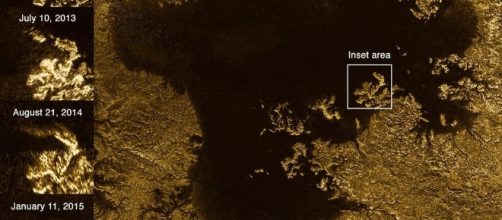NASA's Cassini Mission conducted various researches on Titan, Saturn's moon in 2013, and during the mission, they encountered a mystery that was quite hard to solve; the magic islands. Unexplained bright regions that wink in and out were found on Ligeia Mare, the second largest water body on Saturn's surface.
Now a new study has revealed that these magical islands are basically streams of nitrogen bubbles that appear and vanish in random speed. The study was conducted by a team of researchers led by Daniel Cordier, a space scientist at the University of Reims Champagne-Ardenne, France.
The findings of this study are published in the Journal, 'Nature Astronomy.'
The mystery behind disappearing islands
Several studies that were conducted on Titan's seas indicated that these bodies are combustible in nature and it appears dark all the time. It was in 2013 when these glaring anomalies first caught the attention of scientists. Several hypotheses which explained the secret behind these winking islands were proposed by various researchers, and one among them was the possibility of Titan's sea eruption with the creation of bubble patches. Now, the new research has put forward scientific evidence stating that bubbles filled with ethane, methane, and nitrogen are responsible for this strange phenomenon.
Scientists have solved the mystery of "magic islands" on Saturn's largest moon https://t.co/WlAtsPvaPh pic.twitter.com/ck9OhGrIsi
— CNN (@CNN) April 19, 2017
The study found that specific temperatures and environment changes under the hydrocarbon sea is the main reason behind the appearance of nitrogen bubbles over the sea's surface. In order to make this conclusion, the team of scientists developed various computer models to understand how liquids and gasses will act on the sea of Titan. The team also analyzed the behavior of other similar fluids in pressurized conditions which helped them to unravel the mystery behind these magical islands.
And the secret behind Titan's "magic islands" is... bubbles (?!) https://t.co/hIaweDFHXl pic.twitter.com/090fKIcwhg
— SPACE.com (@SPACEdotcom) April 19, 2017
Nitrogen bubbles behind shining islands
Nitrogen bubbles are reflective to radio waves, and this is why they appear bright under radar images.
According to experts, these nitrogen bubbles may grow up to 1.8 inches in width, and its depth may go beyond 600 feet.
In a recently issued statement, Cordier told that the future Titan missions which aim to deploy submarines on Titan's sea should study more about this strange characteristic. He also added that the research team should study about the possible instabilities under the depths of the sea. Do you think the reason is bubbles?

